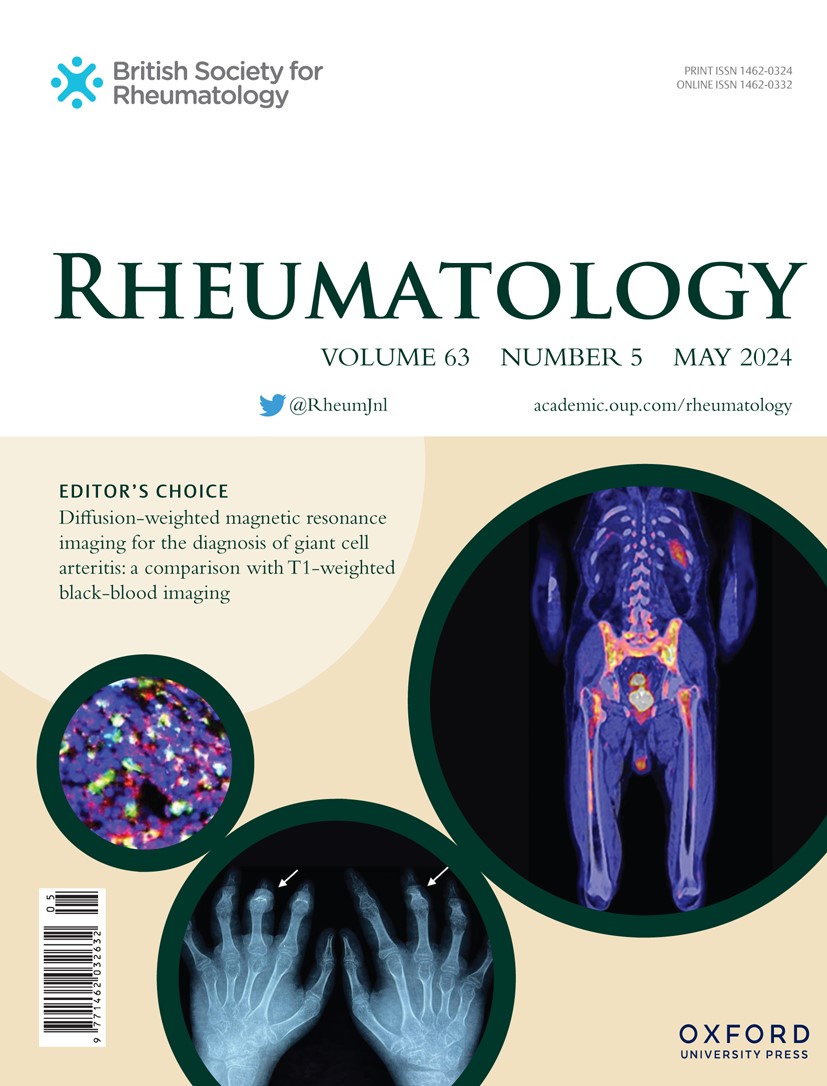When to address fatigue in juvenile idiopathic arthritis during clinical visits based on the JAMAR
IF 4.7
2区 医学
Q1 RHEUMATOLOGY
引用次数: 0
Abstract
Objectives Fatigue is a prevalent but overlooked issue among patients with Juvenile Idiopathic Arthritis (JIA) in clinical practice. The internationally widely used Juvenile Arthritis Multidimensional Assessment Report (JAMAR) does not include items on fatigue. We evaluated whether items from its Quality of Life (QoL) section could be used as proxy measurement for fatigue, prompting practitioners to address issues with fatigue during a clinical visit. Methods 105 JIA patients at the Wilhelmina Children’s Hospital (WCH) completed the JAMAR and Checklist Individual Strength-8 (CIS-8), a questionnaire with validated cut-off score for severe fatigue in rheumatic conditions. Correlations were inspected to test whether QoL items 3 (difficulty with energy-demanding activities) and 9 (concentration or attention issues) correlated strongest with severe fatigue. With binary logistic regressions and ROC analyses, the proxy’s predictive value and cut-off were determined. The proxy was re-used in the EPOCA cohort for comparison. Results The proposed items showed the strongest correlation with severe fatigue (ritem3=0.644 and ritem9=0.565). Their sum score represented the proxy (range 0–6). The proxy was a significant predictor of severe fatigue controlled for age, sex, and disease activity (p<0.001). Area Under the Curve was 0.911, sensitivity 90% and specificity 69.6% with cut-off score ≥1. According to the proxy, fatigue should be addressed in 58.1% of WCH patients and in 56.6% of the EPOCA cohort. Conclusion The proxy can be used to estimate whether issues with fatigue should be explored during clinical visits. To quantify fatigue severity levels, we recommend using the CIS-8 or another fatigue questionnaire.在基于jama的临床访问中,何时解决青少年特发性关节炎的疲劳问题
目的:在临床实践中,疲劳是青少年特发性关节炎(JIA)患者普遍存在但却被忽视的问题。国际上广泛使用的青少年关节炎多维评估报告(JAMAR)不包括疲劳项目。我们评估了其生活质量(QoL)部分的项目是否可以用作疲劳的替代测量,促使从业者在临床就诊期间解决疲劳问题。方法Wilhelmina儿童医院(WCH) 105例JIA患者完成了JAMAR和个人力量-8量表(CIS-8),这是一份针对风湿性疾病严重疲劳的有效截止评分问卷。对QoL项目3(高能量活动困难)和9(集中或注意力问题)是否与严重疲劳最相关进行了相关性检验。采用二元logistic回归和ROC分析,确定代理的预测值和截止值。在EPOCA队列中重复使用代理进行比较。结果建议项目与严重疲劳的相关性最强(ritem3=0.644, ritem9=0.565)。他们的总得分代表代理(范围0-6)。该代理是受年龄、性别和疾病活动控制的严重疲劳的显著预测因子(p<0.001)。曲线下面积为0.911,灵敏度90%,特异性69.6%,截止评分≥1。根据代理,58.1%的WCH患者和56.6%的EPOCA队列患者应解决疲劳问题。结论该指标可用于评估是否应在临床就诊时探讨疲劳问题。为了量化疲劳严重程度,我们建议使用CIS-8或其他疲劳问卷。
本文章由计算机程序翻译,如有差异,请以英文原文为准。
求助全文
约1分钟内获得全文
求助全文
来源期刊

Rheumatology
医学-风湿病学
CiteScore
9.40
自引率
7.30%
发文量
1091
审稿时长
2 months
期刊介绍:
Rheumatology strives to support research and discovery by publishing the highest quality original scientific papers with a focus on basic, clinical and translational research. The journal’s subject areas cover a wide range of paediatric and adult rheumatological conditions from an international perspective. It is an official journal of the British Society for Rheumatology, published by Oxford University Press.
Rheumatology publishes original articles, reviews, editorials, guidelines, concise reports, meta-analyses, original case reports, clinical vignettes, letters and matters arising from published material. The journal takes pride in serving the global rheumatology community, with a focus on high societal impact in the form of podcasts, videos and extended social media presence, and utilizing metrics such as Altmetric. Keep up to date by following the journal on Twitter @RheumJnl.
 求助内容:
求助内容: 应助结果提醒方式:
应助结果提醒方式:


